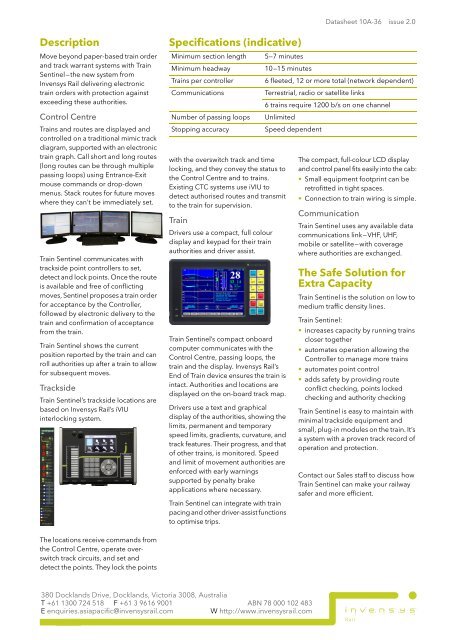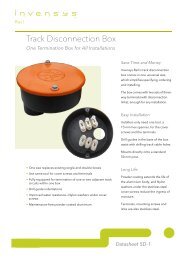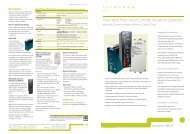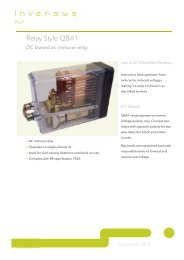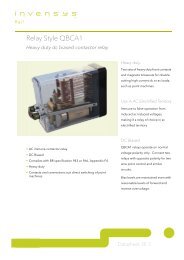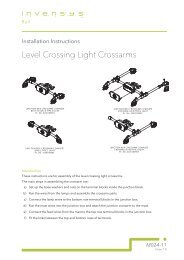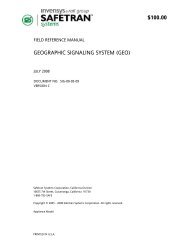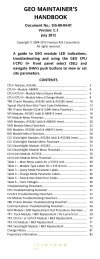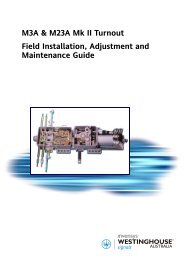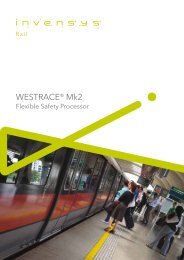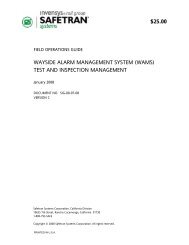Datasheet 10A-36 (issue 2.0) Train Sentinel - Invensys Rail
Datasheet 10A-36 (issue 2.0) Train Sentinel - Invensys Rail
Datasheet 10A-36 (issue 2.0) Train Sentinel - Invensys Rail
You also want an ePaper? Increase the reach of your titles
YUMPU automatically turns print PDFs into web optimized ePapers that Google loves.
Description<br />
Move beyond paper-based train order<br />
and track warrant systems with <strong>Train</strong><br />
<strong>Sentinel</strong>—the new system from<br />
<strong>Invensys</strong> <strong>Rail</strong> delivering electronic<br />
train orders with protection against<br />
exceeding these authorities.<br />
Control Centre<br />
<strong>Train</strong>s and routes are displayed and<br />
controlled on a traditional mimic track<br />
diagram, supported with an electronic<br />
train graph. Call short and long routes<br />
(long routes can be through multiple<br />
passing loops) using Entrance-Exit<br />
mouse commands or drop-down<br />
menus. Stack routes for future moves<br />
where they can't be immediately set.<br />
<strong>Train</strong> <strong>Sentinel</strong> communicates with<br />
trackside point controllers to set,<br />
detect and lock points. Once the route<br />
is available and free of conflicting<br />
moves, <strong>Sentinel</strong> proposes a train order<br />
for acceptance by the Controller,<br />
followed by electronic delivery to the<br />
train and confirmation of acceptance<br />
from the train.<br />
<strong>Train</strong> <strong>Sentinel</strong> shows the current<br />
position reported by the train and can<br />
roll authorities up after a train to allow<br />
for subsequent moves.<br />
Trackside<br />
<strong>Train</strong> <strong>Sentinel</strong>’s trackside locations are<br />
based on <strong>Invensys</strong> <strong>Rail</strong>’s iVIU<br />
interlocking system.<br />
The locations receive commands from<br />
the Control Centre, operate overswitch<br />
track circuits, and set and<br />
detect the points. They lock the points<br />
Specifications (indicative)<br />
with the overswitch track and time<br />
locking, and they convey the status to<br />
the Control Centre and to trains.<br />
Existing CTC systems use iVIU to<br />
detect authorised routes and transmit<br />
to the train for supervision.<br />
<strong>Train</strong><br />
Drivers use a compact, full colour<br />
display and keypad for their train<br />
authorities and driver assist.<br />
<strong>Train</strong> <strong>Sentinel</strong>’s compact onboard<br />
computer communicates with the<br />
Control Centre, passing loops, the<br />
train and the display. <strong>Invensys</strong> <strong>Rail</strong>’s<br />
End of <strong>Train</strong> device ensures the train is<br />
intact. Authorities and locations are<br />
displayed on the on-board track map.<br />
Drivers use a text and graphical<br />
display of the authorities, showing the<br />
limits, permanent and temporary<br />
speed limits, gradients, curvature, and<br />
track features. Their progress, and that<br />
of other trains, is monitored. Speed<br />
and limit of movement authorities are<br />
enforced with early warnings<br />
supported by penalty brake<br />
applications where necessary.<br />
<strong>Train</strong> <strong>Sentinel</strong> can integrate with train<br />
pacing and other driver-assist functions<br />
to optimise trips.<br />
380 Docklands Drive, Docklands, Victoria 3008, Australia<br />
T +61 1300 724 518 F +61 3 9616 9001 ABN 78 000 102 483<br />
E enquiries.asiapacific@invensysrail.com W http://www.invensysrail.com<br />
<strong>Datasheet</strong> <strong>10A</strong>-<strong>36</strong> <strong>issue</strong> <strong>2.0</strong><br />
Minimum section length 5—7 minutes<br />
Minimum headway 10—15 minutes<br />
<strong>Train</strong>s per controller 6 fleeted, 12 or more total (network dependent)<br />
Communications Terrestrial, radio or satellite links<br />
6 trains require 1200 b/s on one channel<br />
Number of passing loops Unlimited<br />
Stopping accuracy Speed dependent<br />
The compact, full-colour LCD display<br />
and control panel fits easily into the cab:<br />
• Small equipment footprint can be<br />
retrofitted in tight spaces.<br />
• Connection to train wiring is simple.<br />
Communication<br />
<strong>Train</strong> <strong>Sentinel</strong> uses any available data<br />
communications link—VHF, UHF,<br />
mobile or satellite—with coverage<br />
where authorities are exchanged.<br />
The Safe Solution for<br />
Extra Capacity<br />
<strong>Train</strong> <strong>Sentinel</strong> is the solution on low to<br />
medium traffic density lines.<br />
<strong>Train</strong> <strong>Sentinel</strong>:<br />
• increases capacity by running trains<br />
closer together<br />
• automates operation allowing the<br />
Controller to manage more trains<br />
• automates point control<br />
• adds safety by providing route<br />
conflict checking, points locked<br />
checking and authority checking<br />
<strong>Train</strong> <strong>Sentinel</strong> is easy to maintain with<br />
minimal trackside equipment and<br />
small, plug-in modules on the train. It’s<br />
a system with a proven track record of<br />
operation and protection.<br />
Contact our Sales staff to discuss how<br />
<strong>Train</strong> <strong>Sentinel</strong> can make your railway<br />
safer and more efficient.


